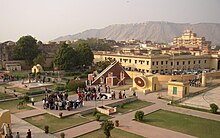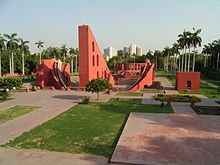Jantar Mantar
Jantar Mantar ( Sanskrit ; translated: "Magical Device") is the name of five historical astronomical observatories that Maharajah Jai Singh II had built between 1724 and 1734 in Delhi , Ujjain , Mathura , Varanasi and Jaipur . Nasīr ad-Dīn at-Tūsī's observatory in Maragha and Ulug Beg's observatory in Samarkand served as models .
In all of these observatories, the scales have been enlarged and enlarged to achieve a precise angle reading. Tycho Brahe had also followed this path with his wall quadrant in his observatory on the island of Hven . In the following years, however, Europe focused on precision mechanics, i. H. more precise graduations on small instruments and on the telescope.
Surname
The name Jantar Mantar is derived from the yantra instrument and mantra formula or calculation. Hence the name Jantar Mantar literally means calculating instrument.
Jantar Mantar in Jaipur
Location: 26 ° 55 ′ 28.5 ″ N , 75 ° 49 ′ 27.3 ″ E
The largest of these facilities was built from 1727 to 1733 in the new capital Jaipur, based on the model of the observatory in Delhi. It houses 14 buildings designed according to astronomical criteria. These are used, among other things, to measure time , predict eclipses , observe the orbits of the planets , determine astronomical altitude and declination, and create ephemeris . The largest building is the Samrat Jantar , a sundial with a height of 27 m, which can show the time to about 2s.
The complex was restored in 1901 and declared a National Monument of India in 1948 . In 2010 the observatory was recognized as a UNESCO World Heritage Site.
Jantar Mantar in Delhi
The observatory in Delhi was built from 1724 and is the first of the five facilities built by Jai Singh II. The data served not only pure astronomy, but above all the astrological inclinations of the ruler.
Jantar Mantar in Ujjain
The observatory in Ujjain, one of the seven holy cities of India, was built on the longitude to which all Hindu astronomers have always referred the ephemeris : 75.78 ° East (based on Greenwich). It corresponds to our prime meridian through the Royal Greenwich Observatory . You can still see the sundial Vedha Shala .
Web links
- Jaipur - Jantar Mantar (with schematic picture)
- The sky clock , SWR school television
- Indian Astronomy and Observatories - Jantar Mantar
- English
- Jantar Mantar website
- Entry on the UNESCO World Heritage Center website ( English and French ).
- Architecture in the Service of Science (PDF file; 983 kB)
- Website for Jantar Mantar in Jaipur - Biggest Stone Observatory in the World (Info)
- French





